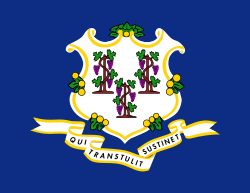Flag of Connecticut
The flag of the state of Connecticut is a black baroque shield with three grapevines, each bearing three bunches of purple grapes on a field of royal blue. The banner below the shield reads "Qui Transtulit Sustinet", Latin for "He who transplanted sustains"), Connecticut's state motto. The flag dimensions are 5.5 feet (1.7 m) in length and 4.33 feet (1.32 m) in width.[1]
 | |
| Use | Civil and state flag |
|---|---|
| Proportion | 3:4 |
| Adopted | September 9, 1897 |
| Design | White shield with three grapevines on a field of azure blue. |
History
The Connecticut General Assembly approved the flag in 1897 after it was introduced by Governor Owen Vincent Coffin in 1895.[1]
The design comes from the seal of Saybrook Colony, designed by George Fenwick when it was established in 1639. That seal depicted 15 grapevines and a hand in the upper left corner with a scroll reading "Sustinet qui transtulit". When Connecticut Colony bought Saybrook in 1644, the seal transferred to Connecticut Colony. On October 25, 1711, the governor and legislature changed the seal. They reduced the number of grapevines from 15 to three, in order to represent the three oldest settlements (Windsor, Wethersfield, and Hartford)[2] (or possibly the three separate vfsettlements, Connecticut Colony, Saybrook Colony, and New Haven Colony, which had been absorbed into Connecticut by that time) and rearranged the wording and position of the motto.
In 2001, the North American Vexillological Association surveyed its members on the designs of the 72 U.S. state, U.S. territorial and Canadian provincial flags. The survey ranked the Connecticut flag 50th out of 72.[3]
.svg.png) The naval Red Ensign of the former Kingdom of England from which the flags of New England are derived.[4]
The naval Red Ensign of the former Kingdom of England from which the flags of New England are derived.[4].svg.png) The First Flag (and Ensign) of New England, used by Colonial merchant ships sailing out of New England ports, 1686-c.1737.
The First Flag (and Ensign) of New England, used by Colonial merchant ships sailing out of New England ports, 1686-c.1737..svg.png) After the union of England and Scotland, some New England ensigns used the British Union Flag rather than the St George's Cross.[5]
After the union of England and Scotland, some New England ensigns used the British Union Flag rather than the St George's Cross.[5].svg.png) The Flag of New England during the Revolutionary War.[6]
The Flag of New England during the Revolutionary War.[6] Flag flown during the Dominion of New England using the personal standard of Edmund Andros
Flag flown during the Dominion of New England using the personal standard of Edmund Andros
Flying the flag at half mast
The flag is traditionally at half mast when the American flag is flown at half mast, which may be ordered by the President or by the Governor.[7] According to 2007-R-0624, only the governor of Connecticut may decide to fly the state flag at half mast, though the right is a power of office and not a law. Typically this is done upon the death of a Connecticut resident in the armed forces,[8] but has been done in the past for the funerals of past state governors, state representatives,or for an event considered tragic for the state.[9]
See also
- State of Connecticut
- Symbols of the state of Connecticut
- Great Seal of the State of Connecticut
- Coat of arms of Connecticut
- Symbols of the state of Connecticut
References
- "The State Flag". CT.gov. Department of Information Technology, State of Connecticut. Retrieved 2013-11-30.
- "Virtual Tour of the Connecticut Supreme Court Courtroom - text only". Jud.ct.gov. State of Connecticut. Retrieved 2013-11-30.
- "2001 State/Provincial Flag Survey - NAVA.org" (PDF). nava.org.
- Edward O’Connor. "Alternate flags for New England". E. O’Connor. Retrieved 2008-01-29.
- Historical Flags of Our Ancestors. "Flags of the American Revolution Era". Loeser.is. Retrieved 24 June 2019.
- "New England flags (U.S.)". Crwflags.com. Retrieved 2008-11-07.
- https://web.archive.org/web/20100527180547/http://www.senatedems.ct.gov/enews/archive/Duff-1001-web.html. Archived from the original on May 27, 2010. Retrieved April 13, 2010. Missing or empty
|title=(help) - "Displaying the US and State Flag at Half Staff in Connecticut and Other States". Cga.ct.gov. State of Connecticut. 2007-11-06. Retrieved 2013-11-30.
- {{cite web|author=Executive Office of Governor John G. Rowland |url=http://www.ct.gov/governorrowland/cwp/view.asp?A=1336&Q=257894 |title=Governor Rowland: Governor Rowland Orders Flags Flown Half Staff in Honor of M. Adela Eads |publisher=State of Connecticut|work=Ct.gov |date= |access
